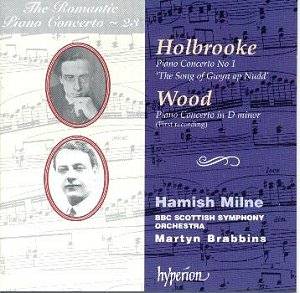Joseph HOLBROOKE (1878-1958)
Piano Concerto No. 1 'The Song of Gwyn ap
Nudd'
Haydn WOOD (1882-1959)
Piano Concerto in D minor (first recording)
 Hamish Milne (piano) BBC Scottish
Orchestra conducted by Martyn Brabbins.
Hamish Milne (piano) BBC Scottish
Orchestra conducted by Martyn Brabbins.
 Hyperion CDA67127 [69:19]
Hyperion CDA67127 [69:19]

Quelle surprise! This album could almost qualify to be included in
my 'If Only They Had Written for Films…' series over on our companion
site Film Music on the Web. For Joseph Holbrooke's Piano Concerto No.
1 'The Song of Gwyn ap Nudd' sounds very much like a film
score. Indeed, Lewis Foreman, in his perceptive notes, remarks that Holbrooke's
music, in covering the changing scenes of the narrative of the Welsh legend
as retold by Lord Howard de Walden (T E Ellis), "almost anticipates
'cross-cutting as in the cinema." The story of the poem is about risen spirits,
Gwyn ap Nudd the King of the Faerie and his rival Gwythyr ap Greidawl, who
are condemned to battle over the fair Cordelia on the night of the first
of May every year. (It brings to mind the recent film Sleepy
Hollow based on the story of Washington Irving)
Holbrooke's music is linked to the text in the booklet by a series of 22
cues so that one can follow the story line-by-line through its musical
evocations. The first movement covers the rising and arming of Gwyn ap Nudd
and there is reference to the reason for his warring - the fair Cordelia.
Holbrooke's music is dramatic, even melodramatic and very much in the red-blooded
late Romantic tradition with heavily atmospheric misty moonlight and woodlands
music; and material suggesting medieval chivalry and combat, contrasted with
a broad romantic melody associated with Cordelia that Max Steiner would not
have sniffed at. The second movement, associated with phantom memories of
Cordelia begins with mordant horn calls answered by muted strings to give
the music a spectral, twilight quality. The music then lightens to become
almost salon music and assumes the style of a waltz before the movement ends
with darker elements announcing the combat that is furious indeed. It dies
away as dawn approaches and the combatants retreat until another year's summons
and we hear a reprise of much of the foregoing material culminating in an
exultant rendering of the Cordelia theme (quite Rachmaninov-like), the Sing
of Gwyn ap Nudd!
The Haydn Wood Concerto comes as something of a surprise too - one is so
used to thinking of Wood in terms of light music and categorising him as
the leader in this genre together with Eric Coates and Montague Philips.
His Concerto is a very considerable work of some 33 minutes duration. It
has great power; watch your floorboards quiver! Again one could consider
its passionate, romantic language very suitable for the screen. Why British
studios overlooked it, is a mystery - it would have been perfect for one
of those Gainsborough films of the 1940s. The opening movement begins very
dramatically but there is also music of grace and tenderness. The influence
of the Russian romantics is apparent - especially Tchaikovsky and Rachmaninov
- in the glorious romantic melodies of the opening movement. The second movement
is ushered in by muted strings in contemplative mood with the piano embroidering
their wistfulness. This is autumnal music of melancholy nostalgia and regret.
The Finale returns to the more overt drama and romance of the opening movement.
And again there is a big romantic tune to appeal to film producers. The whole
work offers an opportunity for pianists to display their virtuosity and Hamish
Milne grasps it with both hands. Haydn Wood was also an accomplished
orchestrator; he does not forget to write interesting material for each section
of the orchestra and the BBC Scottish Orchestra respond warmly with a truly
committed performance.
Unhesitatingly recommended
Reviewer
Ian Lace


![]()